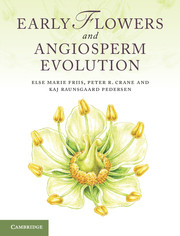Book contents
- Frontmatter
- Contents
- Preface
- 1 Introduction to angiosperms
- 2 The nature of the angiosperm fossil record
- 3 The environmental context of early angiosperm evolution
- 4 Stratigraphic framework and key areas for Cretaceous angiosperms
- 5 Angiosperms in context: extant and fossil seed plants
- 6 Origin and age of angiosperms
- 7 Phylogenetic framework and the assignment of fossils to extant groups
- 8 Fossils near the base of the angiosperm tree
- 9 Early fossil angiosperms of uncertain relationships
- 10 Early fossils of eumagnoliids
- 11 Fossils of monocots
- 12 Fossils of eudicots: early-diverging groups
- 13 Fossils of core eudicots: basal lineages
- 14 Fossils of core eudicots: rosids
- 15 Early fossils of eudicots: asterids
- 16 Patterns of structural diversification in angiosperm reproductive organs
- 17 History and evolution of pollination in angiosperms
- 18 History and evolution of dispersal in angiosperms
- 19 Vegetational context of early angiosperm diversification
- 20 The accumulation of angiosperm diversity
- References
- Index
6 - Origin and age of angiosperms
Published online by Cambridge University Press: 07 September 2011
- Frontmatter
- Contents
- Preface
- 1 Introduction to angiosperms
- 2 The nature of the angiosperm fossil record
- 3 The environmental context of early angiosperm evolution
- 4 Stratigraphic framework and key areas for Cretaceous angiosperms
- 5 Angiosperms in context: extant and fossil seed plants
- 6 Origin and age of angiosperms
- 7 Phylogenetic framework and the assignment of fossils to extant groups
- 8 Fossils near the base of the angiosperm tree
- 9 Early fossil angiosperms of uncertain relationships
- 10 Early fossils of eumagnoliids
- 11 Fossils of monocots
- 12 Fossils of eudicots: early-diverging groups
- 13 Fossils of core eudicots: basal lineages
- 14 Fossils of core eudicots: rosids
- 15 Early fossils of eudicots: asterids
- 16 Patterns of structural diversification in angiosperm reproductive organs
- 17 History and evolution of pollination in angiosperms
- 18 History and evolution of dispersal in angiosperms
- 19 Vegetational context of early angiosperm diversification
- 20 The accumulation of angiosperm diversity
- References
- Index
Summary
A convincing hypothesis of angiosperm origins in the context of a secure understanding of seed plant phylogeny still remains to be achieved. A major impediment is the need for improved information on fossil seed plants, but there are also other challenges, particularly concerning how best to integrate the massive and increasing disparity between what is known about the genomes of living plants and what is known about the morphology and anatomy of extinct and extant taxa. In this chapter we briefly review the development of ideas concerning seed plant phylogeny and outline the status of research in this area. We also review the implications of ideas on relationships for understanding the origin and age of angiosperms.
Hypotheses of seed plant relationships
Ideas on relationships among seed plants that developed in the early twentieth century (e.g. Coulter and Chamberlain, 1917; Chamberlain, 1935) focused on gymnosperms (often excluding angiosperms completely) and recognised two groups: cycadopsids and coniferopsids. Cycadopsids included cycads, Bennettitales (Cycadeoidales) and the fossil plants grouped together at that time as seed ferns (e.g. lyginopterids, medullosans). Coniferopsids comprised conifers, cordaites and Ginkgo, and in many schemes also included Gnetales. This biphyletic interpretation of seed plant evolution gathered further support with the recognition of Devonian progymnosperms and the hypothesis that aneurophytalean progymnosperms might have given rise to the cycadopsid line, while archaeopteridalean progymnosperms might have given rise to the coniferopsid line (Beck, 1966, 1970, 1971, 1981). As developed by some authors (e.g. Doyle, 1977), this notion of two main lines of seed plant evolution interpreted angiosperms as the culmination of evolutionary elaboration in the cycadopsid line, while Gnetales were viewed in the equivalent position among coniferopsids (Figure 6.1).
- Type
- Chapter
- Information
- Early Flowers and Angiosperm Evolution , pp. 141 - 162Publisher: Cambridge University PressPrint publication year: 2011

